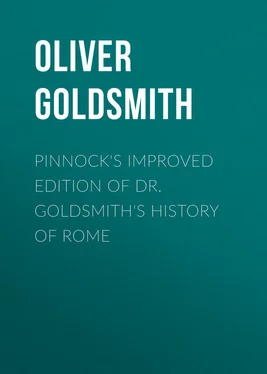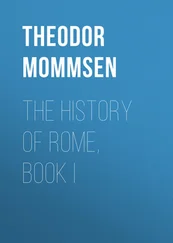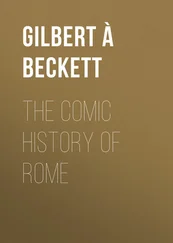Oliver Goldsmith - Pinnock's improved edition of Dr. Goldsmith's History of Rome
Здесь есть возможность читать онлайн «Oliver Goldsmith - Pinnock's improved edition of Dr. Goldsmith's History of Rome» — ознакомительный отрывок электронной книги совершенно бесплатно, а после прочтения отрывка купить полную версию. В некоторых случаях можно слушать аудио, скачать через торрент в формате fb2 и присутствует краткое содержание. Издательство: Иностранный паблик, Жанр: foreign_antique, foreign_prose, на английском языке. Описание произведения, (предисловие) а так же отзывы посетителей доступны на портале библиотеки ЛибКат.
- Название:Pinnock's improved edition of Dr. Goldsmith's History of Rome
- Автор:
- Издательство:Иностранный паблик
- Жанр:
- Год:неизвестен
- ISBN:нет данных
- Рейтинг книги:4 / 5. Голосов: 1
-
Избранное:Добавить в избранное
- Отзывы:
-
Ваша оценка:
- 80
- 1
- 2
- 3
- 4
- 5
Pinnock's improved edition of Dr. Goldsmith's History of Rome: краткое содержание, описание и аннотация
Предлагаем к чтению аннотацию, описание, краткое содержание или предисловие (зависит от того, что написал сам автор книги «Pinnock's improved edition of Dr. Goldsmith's History of Rome»). Если вы не нашли необходимую информацию о книге — напишите в комментариях, мы постараемся отыскать её.
Pinnock's improved edition of Dr. Goldsmith's History of Rome — читать онлайн ознакомительный отрывок
Ниже представлен текст книги, разбитый по страницам. Система сохранения места последней прочитанной страницы, позволяет с удобством читать онлайн бесплатно книгу «Pinnock's improved edition of Dr. Goldsmith's History of Rome», без необходимости каждый раз заново искать на чём Вы остановились. Поставьте закладку, и сможете в любой момент перейти на страницу, на которой закончили чтение.
Интервал:
Закладка:
2. The person who determined the Pomœ'rium yoked a bullock and heifer to a plough, having a copper-share, and drew a furrow to mark the course of the future wall; he guided the plough so that all the sods might fall inwards, and was followed by others, who took care that none should lie the other way. 3. When he came to the place where it was designed to erect a gate, the plough was taken up, 9 9 Hence a gate was called porta , from porta're , to carry. The reason of this part of the ceremony was, that the plough being deemed holy, it was unlawful that any thing unclean should pollute the place which it had touched; but it was obviously necessary that things clean and unclean should pass through the gates of the city. It is remarkable that all the ceremonies here mentioned were imitated from the Tuscans.
and carried to where the wall recommenced. The next ceremony was the consecration of the commit'ium, or place of public assembly. A vault was built under ground, and filled with the firstlings of all the natural productions that sustain human life, and with earth which each foreign settler had brought from his own home. This place was called Mun'dus , and was supposed to become the gate of the lower world; it was opened on three several days of the year, for the spirits of the dead.
4. The next addition made to the city was the Sabine town, 10 10 This, though apparently a mere conjecture, has been so fully proved by Niebuhr, (vol. i. p. 251,) that it may safely be assumed as an historical fact.
which occupied the Quirinal and part of the Capitoline hills. The name of this town most probably was Qui'rium, and from it the Roman people received the name Quirites. The two cities were united on terms of equality, and the double-faced Ja'nus stamped on the earliest Roman coins was probably a symbol of the double state. They were at first so disunited, that even the rights of intermarriage did not exist between them, and it was probably from Qui'rium that the Roman youths obtained the wives 11 11 See Chapter II. of the following history.
by force, which were refused to their entreaties. 5. The next addition was the Cœlian hill, 12 12 All authors are agreed that the Cœlian hill was named from Cœles Viben'na, a Tuscan chief; but there is a great variety in the date assigned to his settlement at Rome. Some make him cotemporary with Rom'ulus, others with the elder Tarquin, or Servius Tullius. In this uncertainty all that can be satisfactorily determined is, that at some early period a Tuscan colony settled in Rome.
on which a Tuscan colony settled; from these three colonies the three tribes of Ram'nes, Ti'ties, and Lu'ceres were formed. 6. The Ram'nes, or Ram'nenses, derived their name from Rom'ulus; the Tities, or Titien'ses, from Titus Tatius, the king of the Sabines; and the Lu'ceres, from Lu'cumo, the Tuscan title of a general or leader. 13 13 Others say that they were named so in honour of Lu'ceres, king of Ardea, according to which theory the third would have been a Pelasgo-Tyrrhenian colony.
From this it appears that the three tribes 14 14 We shall hereafter have occasion to remark, that the Lu'ceres were subject to the other tribes.
were really three distinct nations, differing in their origin, and dwelling apart.
7. The city was enlarged by Tullus Hostilius, 15 15 See History, Chapter IV .
after the destruction of Alba, and the Viminal hill included within the walls; Ancus Martius added mount Aventine, and the Esquiline and Capitoline 16 16 The Pincian and Vatican hills were added at a much later period and these, with Janiculum, made the number ten.
being enclosed in the next reign, completed the number of the seven hills on which the ancient city stood.
8. The hill called Jani'culum, on the north bank of the Tiber, was fortified as an outwork by Ancus Martius, and joined to the city by the bridge; he also dug a trench round the newly erected buildings, for their greater security, and called it the ditch of the Quirites. 9. The public works erected by the kings were of stupendous magnitude, but the private buildings were wretched, the streets narrow, and the houses mean. It was not until after the burning of the city by the Gauls that the city was laid out on a better plan; after the Punic wars wealth flowed in abundantly, and private persons began to erect magnificent mansions. From the period of the conquest of Asia until the reign of Augustus, the city daily augmented its splendour, but so much was added by that emperor, that he boasted that "he found Rome a city of brick, and left it a city of marble."
10. The circumference of the city has been variously estimated, some writers including in their computation a part of the suburbs; according to Pliny it was near twenty miles round the walls. In consequence of this great extent the city had more than thirty gates, of which the most remarkable were the Carmental, the Esquiline, the Triumphal, the Naval, and those called Tergem'ina and Cape'na.
11. The division of the city into four tribes continued until the reign of Augustus; a new arrangement was made by the emperor, who divided Rome into fourteen wards, or regions. 17 17 They were named as follow: 1. Porta Cape'na 2. Cœlimon'tium 3. I'sis and Sera'pis 4. Via Sa'cra 5. Esquili'na 6. Acta Se'mita 7. Vita Lata 8. Forum Roma'num 9. Circus Flamin'ius 10. Pala'tium 11. Circus Max'imus 12. Pici'na Pub'lica 13. Aventinus 14. Transtiberi'na. The divisions made by Servius were named: the Suburan, which comprised chiefly the Cœlian mount; the Colline, which included the Viminal and Quirinal hills; the Esquiline and Palatine, which evidently coincided with the hills of the same name.
The magnificent public and private buildings in a city so extensive and wealthy were very numerous, and a bare catalogue of them would fill a volume; 18 18 Among the public buildings of ancient Rome, when in her zenith, are numbered 420 temples, five regular theatres, two amphitheatres, and seven circusses of vast extent; sixteen public baths, fourteen aqueducts, from which a prodigious number of fountains were constantly supplied; innumerable palaces and public halls, stately columns, splendid porticos, and lofty obelisks.
our attention must be confined to those which possessed some historical importance.
12. The most celebrated and conspicuous buildings were in the eighth division of the city, which contained the Capitol and its temples, the Senate House, and the Forum. The Capitoline-hill was anciently called Saturnius, from the ancient city of Satur'nia, of which it was the citadel; it was afterwards called the Tarpeian mount, and finally received the name of Capitoline from a human head 19 19 From caput , "a head."
being found on its summit when the foundations of the temple of Jupiter were laid. It had two summits; that on the south retained the name Tarpeian; 20 20 State criminals were punished by being precipitated from the Tarpeian rock; the soil has been since so much raised by the accumulation of ruins, that a fall from it is no longer dangerous.
the northern was properly the Capitol. 13. On this part of the hill Romulus first established his asylum, in a sacred grove, dedicated to some unknown divinity; and erected a fort or citadel 21 21 In the reign of Numa, the Quirinal hill was deemed the citadel of Rome; an additional confirmation of Niebuhr's theory, that Quirium was a Sabine town, which, being early absorbed in Rome, was mistaken by subsequent, writers for Cu'res.
on the Tarpeian summit. The celebrated temple of Jupiter Capitoli'nus, erected on this hill, was begun by the elder Tarquin, and finished by Tarquin the Proud. It was burned down in the civil wars between Ma'rius and Syl'la, but restored by the latter, who adorned it with pillars taken from the temple of Jupiter at Olympia. It was rebuilt after similar accidents by Vespa'sian and Domitian, and on each occasion with additional splendour. The rich ornaments and gifts presented to this temple by different princes and generals amounted to a scarcely credible sum. The gold and jewels given by Augustus alone are said to have exceeded in value four thousand pounds sterling. A nail was annually driven into the wall of the temple to mark the course of time; besides this chronological record, it contained the Sibylline books, and other oracles supposed to be pregnant with the fate of the city. There were several other temples on this hill, of which the most remarkable was that of Jupiter Feretrius, erected by Romulus, where the spolia opima were deposited.
Интервал:
Закладка:
Похожие книги на «Pinnock's improved edition of Dr. Goldsmith's History of Rome»
Представляем Вашему вниманию похожие книги на «Pinnock's improved edition of Dr. Goldsmith's History of Rome» списком для выбора. Мы отобрали схожую по названию и смыслу литературу в надежде предоставить читателям больше вариантов отыскать новые, интересные, ещё непрочитанные произведения.
Обсуждение, отзывы о книге «Pinnock's improved edition of Dr. Goldsmith's History of Rome» и просто собственные мнения читателей. Оставьте ваши комментарии, напишите, что Вы думаете о произведении, его смысле или главных героях. Укажите что конкретно понравилось, а что нет, и почему Вы так считаете.











